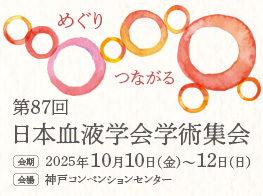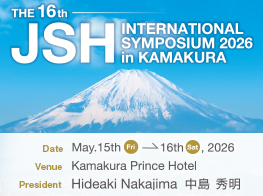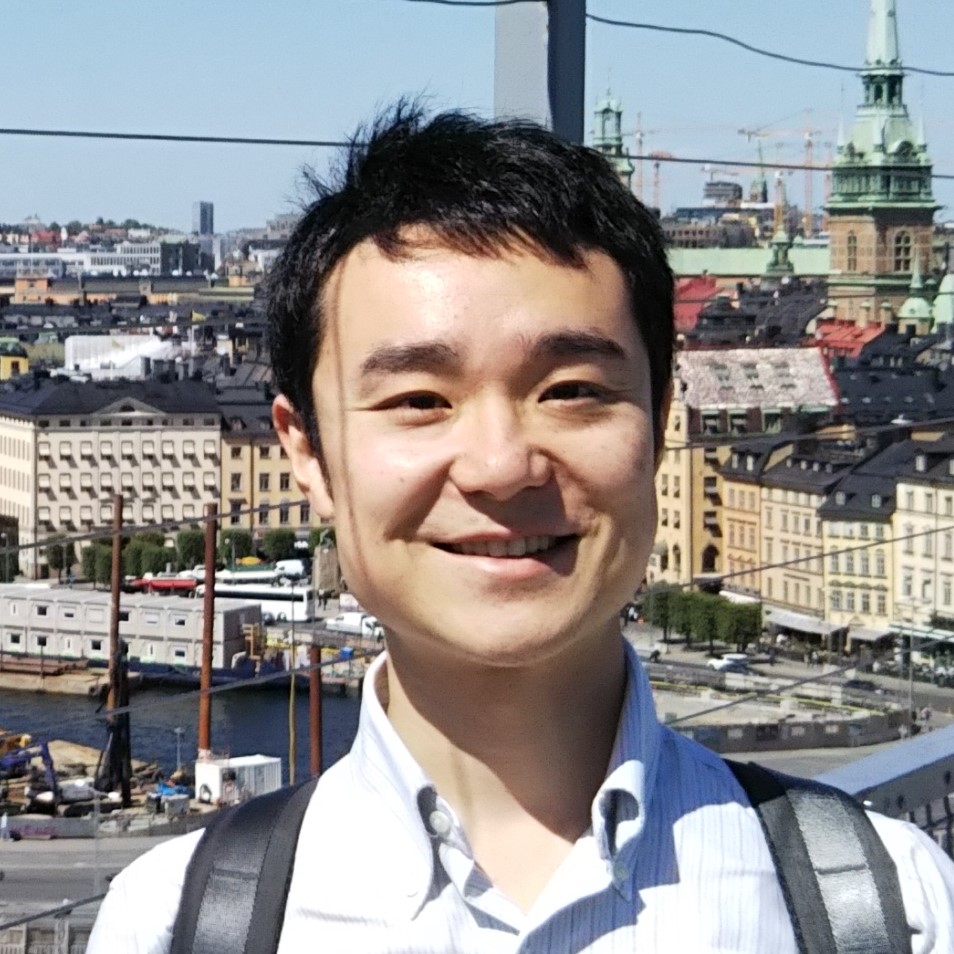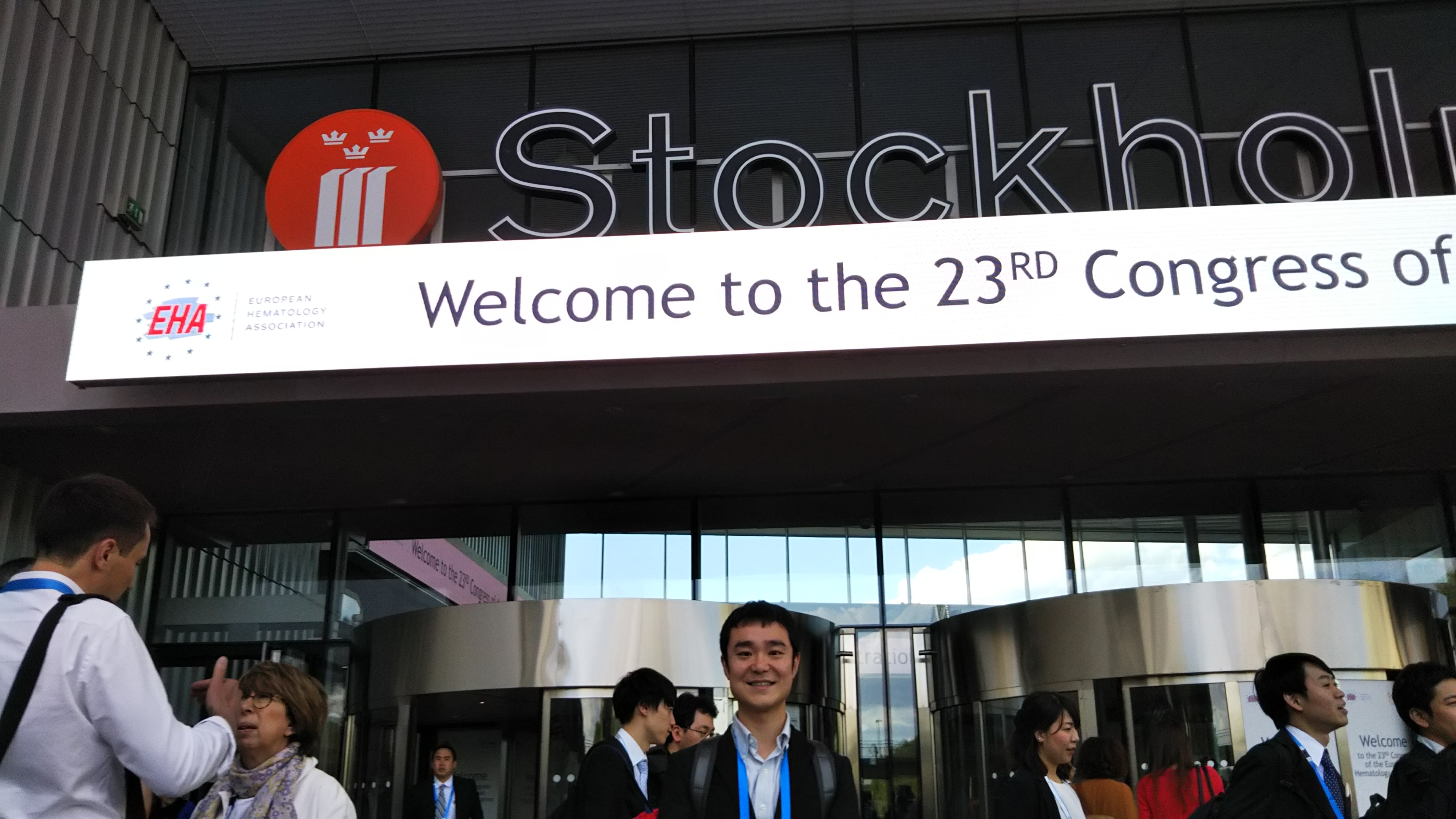名前:木村 俊介【東京大学 小児科】
発表日時:2018年6月16日
発表形式:Poster
Title:
Characterization of pediatric T-cell acute lymphoblastic leukemia with DNA methylation status
Authors:
Shunsuke Kimura1, 2, Masafumi Seki1, Tomoko Kawai3, Kenichi Yoshida4, Tomoya Isobe1, Hiroo Ueno4, Yusuke Shiozawa4, Hiromichi Suzuki4, Yuichi Shiraishi5, Kenichi Chiba5, Kentaro Ohki6, Motohiro Kato6, Katsuyoshi Koh7, Ryoji Hanada7, Hiroshi Moritake8, Ryoji Kobayashi9, Takao Deguchi10, Yoshiko Hashii11, Toshihiko Imamura12, Atsushi Sato13, Nobutaka Kiyokawa6, Atsushi Manabe14, Keizo Horibe15, Akira Ohara16, Masashi Sanada15, Masao Kobayashi2, Akira Oka1, Yasuhide Hayashi17, Satoru Miyano5, Seishi Ogawa4, Kenichiro Hata3, Junko Takita1
Affiliations:
1 Department of Pediatrics, The University of Tokyo, Tokyo, Japan
2 Department of Pediatrics, Hiroshima University Graduate School of Biomedical Sciences, Hiroshima, Japan
3 Department of Maternal-Fetal Biology, National Research Institute for Child Health and Development, Tokyo, Japan
4 Department of Pathology and Tumor Biology, Graduate School of Medicine, Kyoto University, Kyoto, Japan
5 Human Genome Center Institute of Medical Science, The University of Tokyo, Japan
6 Department of Pediatric Hematology and Oncology Research, National Research Institute for Child Health and Development, Tokyo, Japan
7 Department of Hematology/Oncology, Saitama Children's Medical Center, Saitama, Japan
8 Division of Pediatrics, Faculty of Medicine, University of Miyazaki, Miyazaki, Japan
9 Department of Pediatrics, Sapporo Hokuyu Hospital, Sapporo, Japan
10 Department of Pediatrics, Mie University Hospital, Tsu, Japan
11 Department of Pediatrics, Osaka University Graduate School of Medicine, Suita, Japan
12 Department of Pediatrics, Kyoto Prefectural University of Medicine, Graduate School of Medical Science, Kyoto, Japan
13 Department of Hematology and Oncology, Miyagi Children's Hospital, Sendai, Japan
14 Department of Pediatrics, St. Luke's International Hospital, Tokyo, Japan
15 Clinical Research Center, National Hospital Organization Nagoya Medical Center, Nagoya, Japan
16 Department of Pediatrics, Toho University, Tokyo, Japan
17 Gunma Children's Medical Center, Maebashi, Japan
Abstract:
Introduction: Genetic profiles of pediatric T-cell acute lymphoblastic leukemia (T-ALL) have been well studied and we reported recurrent SPI1 fusions associated with dismal prognosis. However, the epigenetic profiles and their potential contribution to clinicopathological features of T-ALL remain largely elusive.
Aims: To describe epigenetic landscape of T-ALL, we performed methylation array analysis.
Methods: Seventy-nine pediatric T-ALL samples mainly obtained from Tokyo Children’s Cancer Study Group (TCCSG) and Japan Association of Childhood Leukemia Study (JACLS) including 7 cases with SPI1 fusions were analyzed using Illumina HumanMethylation EPIC array, and conducted combined analysis whole transcriptome sequencing (WTS) and targeted-capture sequencing for 158 ALL-related genes.
Results: After normalization, 939 probes were selected to identify the most variable methylated probes. Unsupervised consensus clustering clearly identified 4 distinct sample clusters, characterized by TAL1 fusions/high expression with intermediate methylation (M1 cluster; n=39), high TLX/HOX expression with intermediate methylation (M2 cluster; n=20), high TLX//HOX expression with high methylation (M3 cluster; n=11), and SPI1 fusions/high expression with low methylation (M4 cluster; n=9), respectively. In M1 cluster, PTEN alterations were especially enriched, indicating a crucial role of PI3K-AKT pathway in this cluster. In M2 cluster, genes related to chromatin remodeling and JAK-STAT pathway were frequently mutated. DEPTOR related to activation of PI3K-AKT1 pathway was highly expressed. Mutation status of M3 cluster was similar to the M2 cluster, and frequent mutations of epigenetic regulators and JAK-STAT related genes were also observed in M3. Intriguingly, all SPI1 fusion cases were classified into M4 cluster with 2 SPI1 highly expressed cases without SPI1 fusions. In M4 cluster, SPI1 and RASGRP4 were differentially expressed, and significant enrichment in RAS and NF-kB pathways was observed. Importantly, patients in M4 cluster showed significantly poor prognosis (Log-rank p=4.4×10-7). Next, we investigated cell surface markers of each methylation cluster. Cases in M1 cluster exhibited a late cortical thymocyte profile after T-cell receptor gene rearrangement (CD4+CD8+TCRαβ+), whereas most cases in M3 cluster did not show TCRαβ expression (CD4+CD8+TCRαβ-). In M2 and M4 clusters, most cases showed an uncommitted double negative T-cell profile (CD4-CD8-Myeloid+). Furthermore, most cases in M2 cluster represented more early stage of development (M2; CD1a-, M4; CD1a+). Finally, we analyzed CpG island methylator phenotype (CIMP) status of our cohort using previously reported 450K CIMP panel (1,176 probes). As previously reported, two distinct CIMP groups were identified. Cases in M1 and M4 clusters were classified as CIMP-, exhibiting a similar methylation profile to normal CD3+ T-cells. In contrast, cases in M2 and M3 clusters were classified as CIMP+. Importantly, patients with a CIMP- profile had an significantly inferior prognosis (Log-rank p=8.0×10-4).
Conclusions: Based on DNA methylation profiles, pediatric T-ALL is clustered into 4 distinct subtypes, which exhibited remarkable correlation with genetic signatures, expression features, and clinical outcomes as well as profiles of T-cell development. Our results suggested that the biological phenotype of T-ALL is mediated by both genetic and epigenetic regulations, and explorations for aberrant DNA methylation along with genetic alterations might be helpful for a new therapeutic strategy for T-ALL.
EHA2018参加レポート
この度は23rd Congress of European Hematology Association(EHA)への参加にあたり,日本血液学会EHA Travel Awardに採択して頂きありがとうございました。今回のEHAは北欧のスウェーデンの首都であるストックホルムで2018年6月14日から17日まで開催されました。学会会場はストックホルムの中心である中央駅から電車で10分程度の場所の駅に直結しており,アクセスもよく非常に有意義な時間を過ごすことができました。この時期のストックホルムは夏至の1週間前ということもあり,明け方の3時台から日が昇って明るく,日没も夜10時くらいで夜の12時を過ぎても地平線の方はうっすら明るい状態でした。そのため,学会終了後の時間からでも食事や観光など充実した時間を過ごすことができました。一方で冬は太陽が出ている時間が極めて短いため,スウェーデンでは夏至の週の金曜日は国民の祝日(2018年はEHAの1週間後)となるようで,太陽を浴びることのできる短い夏をしっかり楽しむようでした。実際に,外が明るいため時間感覚が全く異なっており,レストランで11時過ぎまで普通に食事をしていたり,深夜12時近くにもかかわらず子供が遊んでいたりと,日本との違いに驚かされました。
私は今回,小児T細胞性急性リンパ性白血病(T-ALL)におけるDNAメチル化の網羅的解析を行い,DNAメチル化による分類が発現や変異パターンだけでなく,予後やT細胞のどの分化段階で腫瘍化しているかにも大きく関連していることを示し,報告させていただきました。我々が先行研究で報告した非常に予後不良なSPI1融合遺伝子症例は,DNAメチル化による分類においても特徴的なパターンを示していました。SPI1だけでなくRASやNF-κB,細胞増殖に関連する遺伝子がDNAメチル化によって高発現となり,RASやMyeloid系のパスウェイの亢進をもたらしていました。今後,これらの知見が新規治療法の開発など臨床的にも応用されていくことが期待されます。
また,私のテーマであるT-ALLに関する演題もたくさんあり,多くの刺激を受けることができました。T-ALLのRPL10変異モデルでBCL2阻害薬の感受性をもたらす原因を追究した報告や,小児T-ALLと低酸素誘導性因子(HIF)の関連と薬剤抵抗性の報告,EZH2のknock outモデルを用いたCHK1経路での合成致死の報告など,興味深いものが非常に多くあり,T-ALLに対して多くの研究者が携わっていることを改めて実感しました。
EHAは参加者がおよそ1万人程度の非常に大きい学会で,これまでの知見をまとめたレクチャーや最新の研究結果まで幅広く網羅されていました。ヨーロッパの方を中心にアジアの国々の参加者が多く,米国の先生の参加者は少ない印象でした。また,会場はコンパクトな作りになっていたため,他の参加者との距離感が近くて相互にコミュニケーションがとりやすい印象を受けました。ポスター会場にも著明な先生方がたくさん参加されていました。そのため,世界の第一線でT-ALLの研究をされているJan Cools先生やMansour先生などにも自分のポスターを紹介する機会を得ることができ,次につながるような有意義なコメントをいただけただけでなく,雑談をしたり記念写真を撮ったりと非常に濃厚な時間を過ごすことができました。
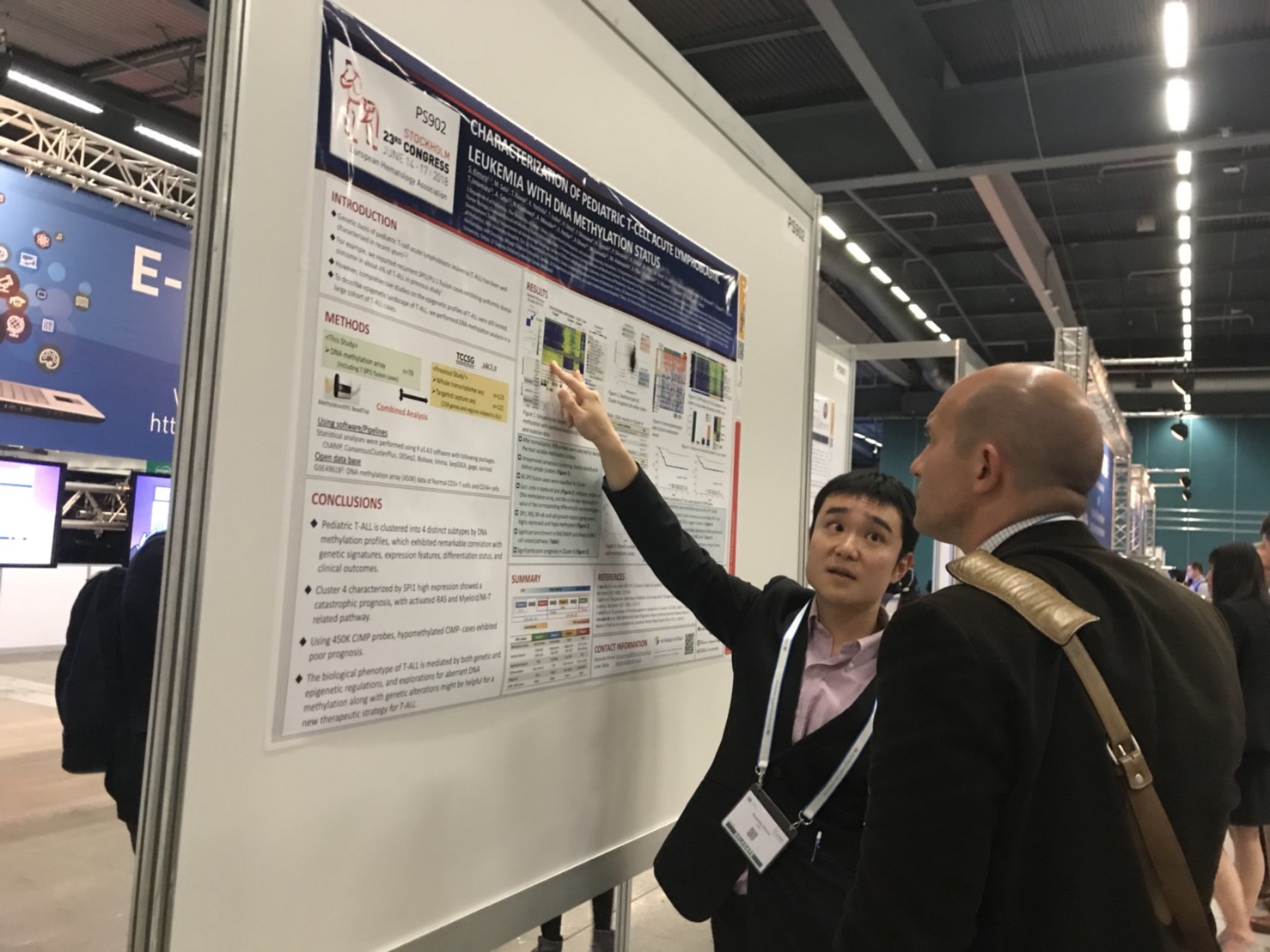
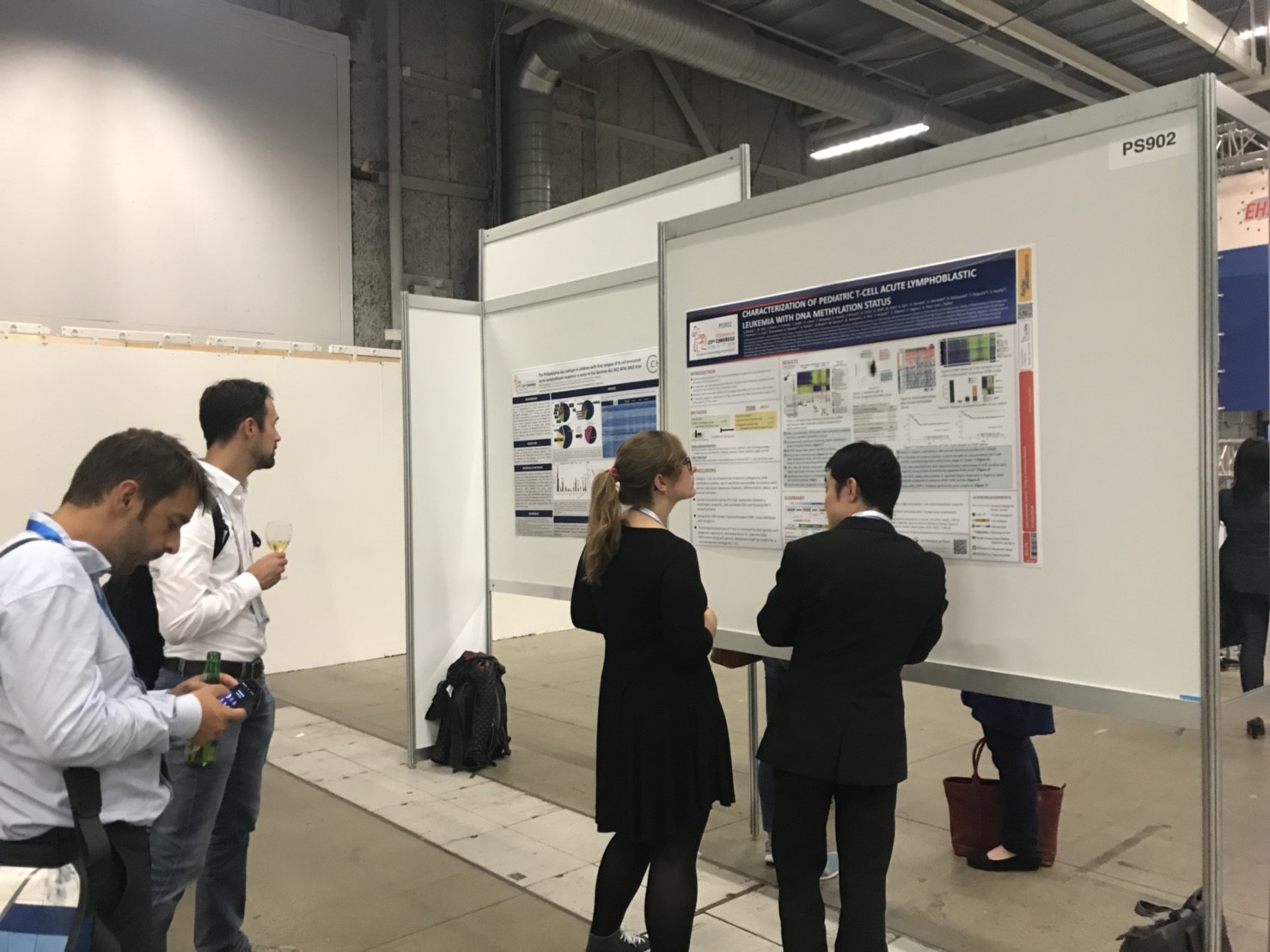
最後になりますが,このような貴重な機会を与えてくださった日本血液学会事務局,国際委員の先生方,そして日頃より研究のご指導を頂いております滝田順子先生,京都大学の小川誠司先生,また検体提供にご同意いただいた患児およびそのご家族のみなさまに心より感謝申し上げます。最後になりますが,このような貴重な機会を与えてくださった日本血液学会事務局,国際委員の先生方,そして日頃より研究のご指導を頂いております滝田順子先生,京都大学の小川誠司先生,また検体提供にご同意いただいた患児およびそのご家族のみなさまに心より感謝申し上げます。

